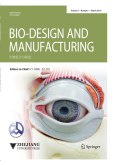- 钛学术文献服务平台 \
- 学术期刊 \
- 基础科学期刊 \
- 生物科学期刊 \
- 生物设计与制造(英文版)期刊 \
A novel bio?active microsphere for meniscus regeneration via inducing cell migration and chondrocyte differentiation
A novel bio?active microsphere for meniscus regeneration via inducing cell migration and chondrocyte differentiation
基本信息来源于合作网站,原文需代理用户跳转至来源网站获取
摘要:
Meniscus injury is a common disease in clinic. If it was not treated in time, it leads to osteoarthritis which brings unbear-able pain and heavy economic burden to the patients. At present, meniscectomy and meniscus suture are widely used in the treatment for meniscus injury. Nevertheless, It is not ideal for poor self-healing ability of meniscus. The recruitment of endogenous stem cells is an attractive option for wounded meniscus healing. Fully reduced high-mobility group box1 protein (HMGB1) can accelerate the regeneration of multiple tissues by endogenous stem cell activation, migration and dif-ferentiation. Kartogenin (KGN) has shown to induce the chondrogenesis of the stem cells. However, no study has explored such effects of HMGB1 and KGN in wounded meniscus healing. Therefore, in order to improve the regeneration of menis-cus, we intend to use a novel bioactive microsphere which was developed by combining fully reduced high mobility group box1 (frHMGB1) and kartogenin (KGN) with alginate gel which slowly release high concentrations of HMGB1 and KGN to activate rat bone marrow stem cells (BMSCs) and promote cell proliferation. The results showed that this HMGB1–KGN microsphere released and kept high concentrations of HMGB1 and KGN in the wound area for more than 2 weeks. Invitro experimental results showed that the HMGB1–KGN microsphere can promote cell proliferation via recruiting rat bone marrow stem cells (BMSCs) and activating the BMSCs from G0 to GAlert stage as evidenced by cell migration testing and 5-bromo-2′-deoxyuridine (BrdU) incorporation assay. In vivo results indicated that this HMGB-KGN microsphere can recruit GFP-labeled BMSCs from tail vein to wounded meniscus and induce these GFP-labeled BMSCs to differentiate into chondrocytes. Our results demonstrated that the HMGB1–KGN-containing bioactive microsphere induced cell migration invitro and recruited the cells to wound area to promote wounded rat meniscus healing invivo.

推荐文章
Carbazoles and benzocarbazoles confirm migration of leaked petroleum through caprocks and overlaying
Migration
Geochromatography
Leakage
North Sea
Valhall
关于Active Worlds在教育领域中的应用
虚拟世界
教育
Active Worlds
改进的Active Bat室内超声波定位方法
ActiveBat
超声波定位
误差修正
基于信令寻径式网络的高性能容错VIA设计与实现
VIA
信令寻径式网络
机群计算
并行处理
内容分析
关键词云
关键词热度
相关文献总数
(/次)
(/年)
文献信息
| 篇名 | A novel bio?active microsphere for meniscus regeneration via inducing cell migration and chondrocyte differentiation | ||
| 来源期刊 | 生物设计与制造(英文版) | 学科 | |
| 关键词 | |||
| 年,卷(期) | 2021,(2) | 所属期刊栏目 | RESEARCH ARTICLES |
| 研究方向 | 页码范围 | 203-221 | |
| 页数 | 19页 | 分类号 | |
| 字数 | 语种 | 英文 | |
| DOI | |||
五维指标
引文网络
引文网络
二级参考文献 (40)
共引文献 (0)
参考文献 (34)
节点文献
引证文献 (0)
同被引文献 (0)
二级引证文献 (0)
1900(1)
- 参考文献(0)
- 二级参考文献(1)
1988(1)
- 参考文献(1)
- 二级参考文献(0)
1992(1)
- 参考文献(1)
- 二级参考文献(0)
1994(1)
- 参考文献(0)
- 二级参考文献(1)
1999(2)
- 参考文献(0)
- 二级参考文献(2)
2000(2)
- 参考文献(0)
- 二级参考文献(2)
2001(3)
- 参考文献(0)
- 二级参考文献(3)
2002(5)
- 参考文献(2)
- 二级参考文献(3)
2003(6)
- 参考文献(0)
- 二级参考文献(6)
2004(3)
- 参考文献(0)
- 二级参考文献(3)
2005(1)
- 参考文献(0)
- 二级参考文献(1)
2006(4)
- 参考文献(1)
- 二级参考文献(3)
2007(2)
- 参考文献(1)
- 二级参考文献(1)
2008(2)
- 参考文献(0)
- 二级参考文献(2)
2009(4)
- 参考文献(3)
- 二级参考文献(1)
2010(4)
- 参考文献(1)
- 二级参考文献(3)
2011(4)
- 参考文献(3)
- 二级参考文献(1)
2012(5)
- 参考文献(4)
- 二级参考文献(1)
2013(7)
- 参考文献(1)
- 二级参考文献(6)
2014(1)
- 参考文献(1)
- 二级参考文献(0)
2015(2)
- 参考文献(2)
- 二级参考文献(0)
2016(3)
- 参考文献(3)
- 二级参考文献(0)
2017(6)
- 参考文献(6)
- 二级参考文献(0)
2018(4)
- 参考文献(4)
- 二级参考文献(0)
2021(0)
- 参考文献(0)
- 二级参考文献(0)
- 引证文献(0)
- 二级引证文献(0)
引文网络交叉学科
相关学者/机构
期刊影响力
生物设计与制造(英文版)
主办单位:
浙江大学
浙江大学出版社
Springer
出版周期:
季刊
ISSN:
2096-5524
CN:
33-1409/Q
开本:
出版地:
杭州市浙大路38号浙大学报英文版编辑部
邮发代号:
创刊时间:
语种:
eng
出版文献量(篇)
118
总下载数(次)
1
总被引数(次)
54
期刊文献
相关文献
推荐文献

 免费查重
免费查重










